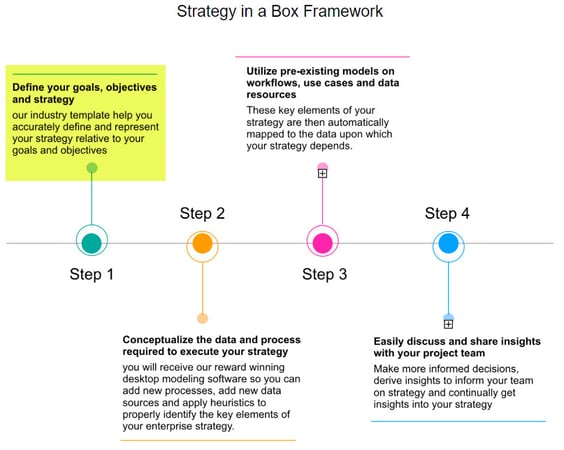How to implement a strategy in 4 Steps.
Strategy is a commodity, execution is an art.
— Peter Drucker
"By bringing strategy, data, and processes into focus, you can understand better the context in which to make decisions."
Interview with CIO Applications on strategy ...
We refer to this as connected planning.
It uses reusable and reconfigurable model components. To understand how this is implemented, look at the four steps below depicted in the Strategy in a Box Framework.

Step 1: Define your Strategy
Define your Project Strategy in terms of its Goals, Objectives, and Measurable Outcomes. See how you can set these up using Planning Statements. Typically, you will define a statement hierarchy. For example, a Goal type of Planning Statement is dependent on meeting certain Objectives and an Objective is dependent upon reaching a certain Outcome. You are also able to relate each Planning Statement to an object. Examples of objects are data catalogs, system resources, or workflow processes.
Step 2: Conceptualize the Workflow and Data Model.
Now you are ready to visualize and model business processes, activities, workflows, data sources and APIs needed to both implement and execute your project strategy. Using Visible's "IntelliViews", a proprietary algorithm that automatically generates views of the data, you will get insights into how well your strategy is doing and whether it results in any unintended consequences.
Step 3: Map your Workflow, Data, and Process Models.
Using the meta store of newly defined Planning Statements and their linkages to objects including Data and Process models created in Steps 1 and 2; now you are ready to map your project's metadata to the appropriate data sources - be it On-Prem or Cloud-based data sources. This optionally may include updates to systems and applications. Ultimately, this step is key to aligning your strategy to the resources and capabilities needed to drive your strategy to execution.
Step 4: Relax...you are now ready to get insights into how your strategy is doing.
Our platform will now automatically map the planning statements you defined with the models you produced to the underlying data sources upon which your strategy depends. At this point, you are able to run ad-hoc queries against any aspect of your strategy to get insights on how your strategy is doing. You can drill down and aggregate data across distributed and disparate data sources. Given the platform's API design, you will be surprised to see how easy it is to run and how simple it is to integrate into your existing IT infrastructure - whether On-Prem or Cloud-based supporting AWS, Azure and Google Cloud.









